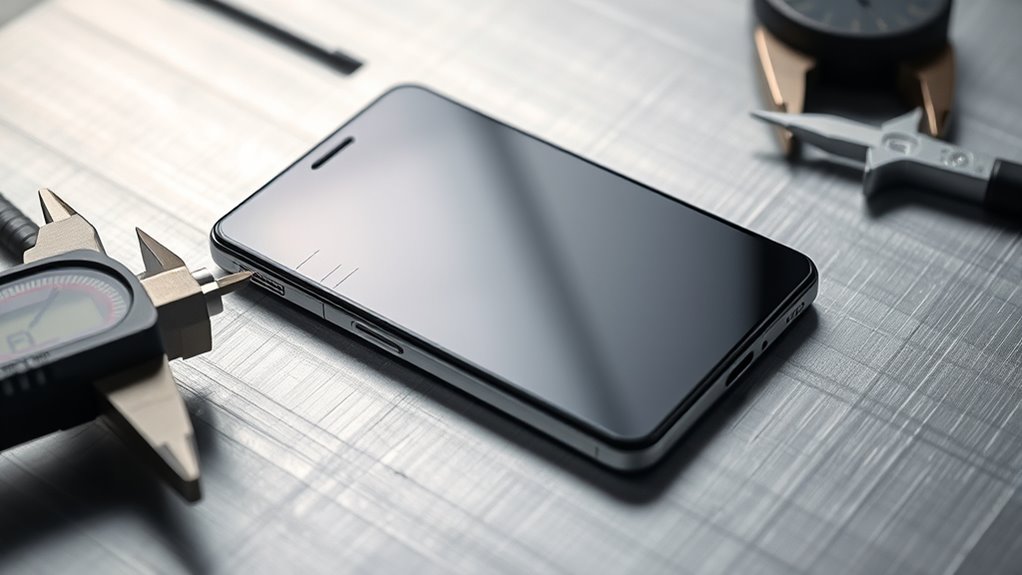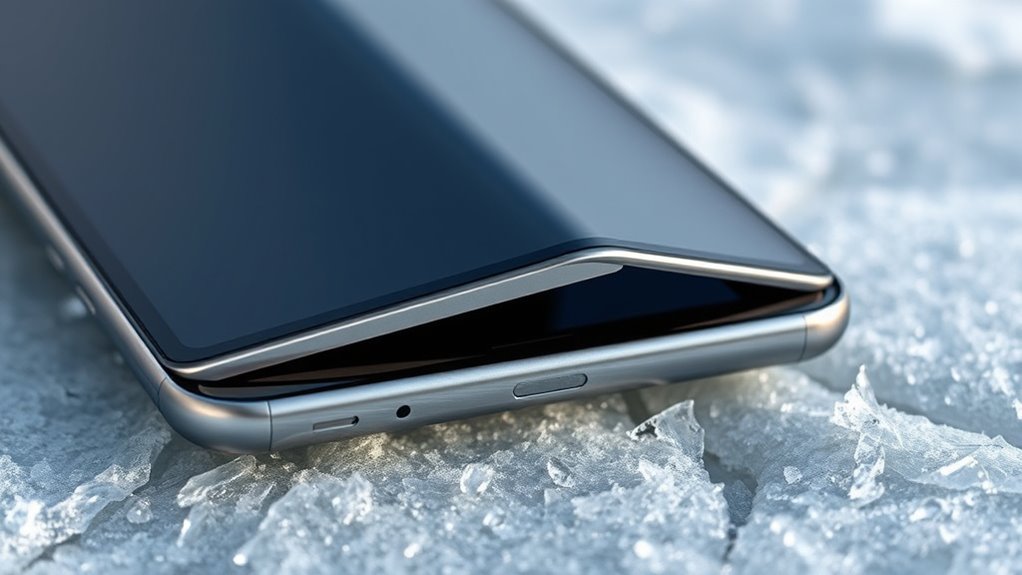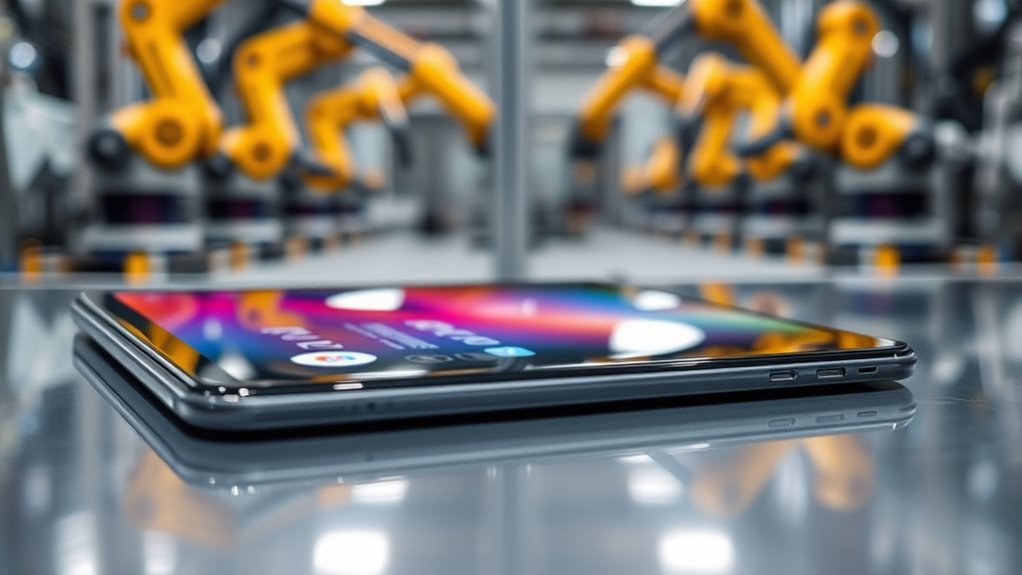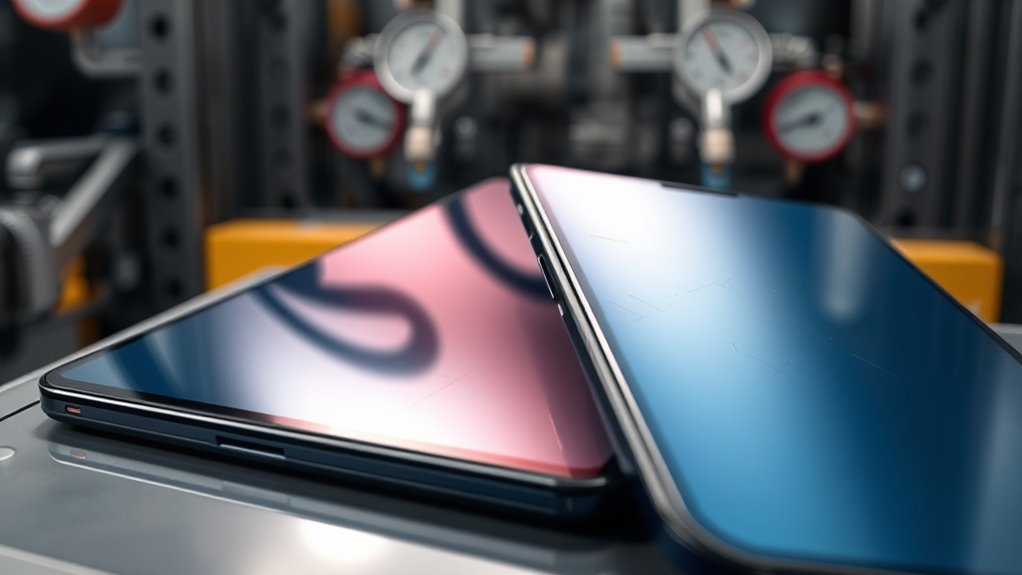Manufacturers test foldable screens by simulating real-world usage through mechanical stress tests, bending and flexing cycles, and impact simulations. They also expose devices to extreme temperatures, humidity, and UV light to verify environmental durability. Repeated folding, twisting, and dropping help identify weak points and material fatigue. These rigorous evaluations guarantee longevity, so if you keep exploring, you’ll discover how they refine these technologies for longer-lasting devices.
Key Takeaways
- Manufacturers conduct repeated folding and unfolding cycles using specialized machines to assess long-term hinge and display durability.
- They perform flexing and bending tests at specific angles and speeds to identify material fatigue and potential failure points.
- Devices are exposed to environmental conditions like high/low temperatures and humidity to evaluate resistance to environmental stress.
- Stress tests include impact simulations, twisting, and bending to mimic real-world mishaps and ensure resilience.
- Durability is gauged through microscopic analysis of material fatigue, crack formation, and long-term wear after extensive cyclical testing.
Mechanical Stress Testing Methods

To guarantee foldable screens can withstand daily use, manufacturers rely on mechanical stress testing methods that simulate real-world conditions. These tests involve applying repeated pressure, force, and flexing to evaluate how the screen responds over time. They mimic everyday actions like opening, closing, and handling the device, ensuring the display can endure millions of folds without failing. The testing equipment exerts precise, controlled forces to detect potential weaknesses or material fatigue. By pushing the screens beyond typical usage scenarios, manufacturers identify vulnerabilities before products reach consumers. This rigorous process helps confirm that foldable displays maintain functionality, flexibility, and durability through prolonged use. Additionally, understanding sound vibrations can provide insights into how materials may respond under stress, aiding in the development of more resilient displays. Ultimately, it ensures you get a reliable device that can handle your daily routines without compromising performance.
Flexing and Bending Durability Tests

Flexing and bending durability tests are essential to assess how well foldable screens can withstand repeated movement without damage. During these tests, you repeatedly fold and unfold the device to simulate everyday use, measuring how many cycles the screen endures before showing signs of wear or failure. Manufacturers use specialized machines that bend screens at specific angles and speeds, monitoring for issues like cracks, delamination, or loss of functionality. These tests help identify weak points in the fold mechanism and screen materials, ensuring the device can handle daily stresses. By pushing screens through extensive flexing, manufacturers verify whether their foldable devices meet durability standards and provide a reliable user experience over time. This process is key to delivering foldables that last, especially considering the importance of material quality in ensuring long-term performance.
Environmental and Temperature Resistance Trials

Environmental and temperature resistance trials are crucial for ensuring foldable screens can perform reliably under varying conditions. These tests expose devices to extreme heat, cold, humidity, and rapid temperature changes to identify potential failure points. You’ll see how screens withstand prolonged exposure to sunlight or cold weather, which can cause material warping or cracking. Manufacturers use specialized equipment to simulate real-world environments, ensuring durability beyond typical usage. Here’s a breakdown of common conditions tested: durability standards.
| Condition | Purpose |
|---|---|
| High temperatures (up to 60°C) | Assess heat resistance and material stability |
| Low temperatures (down to -20°C) | Test flexibility and brittleness in cold weather |
| Humidity exposure | Check for moisture ingress and corrosion |
| Rapid temperature shifts | Evaluate thermal shock resilience |
| UV exposure | Determine effects of sunlight on materials |
Real-World Usage Simulations

You’ll want to contemplate how foldable screens hold up during everyday use, including repeated folding and unfolding. Stress tests reveal how well they resist wear and tear over time. By examining typical usage scenarios, you can better understand their true durability in daily life. Additionally, Mazda Tuning principles can offer insights into how different factors influence performance and longevity under various conditions.
Repeated Folding Tests
To assess a foldable phone’s durability in real-world conditions, manufacturers conduct repeated folding tests that simulate everyday usage. These tests involve repeatedly opening and closing the device to mimic typical user behavior. During testing, you may notice the following key aspects: 1. The number of folds the device can withstand before showing signs of wear or failure. 2. How the hinge mechanism performs after thousands of cycles, including smoothness and stability. 3. The device’s ability to resist creases, scratches, or other damage caused by repeated folding. Additionally, testing often includes evaluating the material properties of the screen and hinge components to ensure long-term resilience.
Durability Under Stress
Real-world usage subjects foldable phones to various stresses that can challenge their durability beyond controlled testing. You might accidentally sit on your phone, drop it, or expose it to harsh environments. Manufacturers simulate these conditions by applying bending, twisting, and impact forces to assess how well the device withstands everyday mishaps. These tests mimic real-life scenarios, like quickly opening and closing the fold or enduring accidental bumps. The goal is to identify potential weak points that could fail under stress. You need your phone to survive sudden jolts or unexpected pressure without compromising the screen or fold mechanism. By simulating these stresses, manufacturers aim to ensure your device remains durable, reliable, and functional, even when faced with the unpredictable challenges of daily life. Additionally, ongoing monitoring of AI safety developments helps improve testing protocols and address vulnerabilities in new materials and designs.
Everyday Usage Scenarios
Everyday activities expose foldable phones to a variety of stresses that can test their durability beyond laboratory conditions. You might fold and unfold your device dozens of times daily, carry it in your pocket with keys or coins, or set it down on uneven surfaces. These actions subject the device to real-world wear and tear. To better understand how foldable phones hold up, manufacturers simulate common scenarios such as:
- Repeatedly opening and closing the device to mimic daily use.
- Carrying the phone in different environments, like pockets or bags, to test impact resistance.
- Dropping or placing the phone on various surfaces to evaluate durability against accidental impacts.
- Incorporating testing techniques like drop tests and bend tests to ensure resilience under various conditions.
These scenarios help guarantee your foldable phone can withstand the unpredictable nature of everyday life.
Material Fatigue Analysis

Material fatigue plays a critical role in determining the lifespan of foldable-screen devices, as repeated bending and flexing cause microscopic damage that accumulates over time. When you fold your device repeatedly, tiny cracks form in the material, weakening its structure. Manufacturers analyze this process through tensile, flexural, and fatigue tests to predict how long the screen can endure stress. These tests simulate real-world usage to identify failure points. The table below summarizes key factors affecting material fatigue:
| Factor | Description | Impact on Durability |
|---|---|---|
| Bending Radius | Degree of curvature during fold | Larger radius reduces stress |
| Fold Frequency | How often you fold/unfold | Higher frequency accelerates fatigue |
| Material Type | Composition of screen material | Stronger materials last longer |
| Flex Cycles | Number of flexing repetitions | More cycles increase damage |
| Environmental Conditions | Temperature, humidity | Adverse conditions accelerate wear |
Additionally, the choice of protective coatings can influence how well the material withstands repeated stress.
Long-Term Wear and Tear Assessments

You need to see how foldable screens hold up over time by examining repeated folding tests and stress cycles. These assessments reveal how bending and stress impact the device’s durability after many uses. Understanding this helps predict the true lifespan of foldable technology.
Repeated Folding Tests
Repeated folding tests are essential for evaluating the durability of foldable screens over time, as they simulate real-world usage to identify potential wear and tear. During these tests, your device is repeatedly folded and unfolded to mimic daily use. This helps reveal how the screen’s hinge, display, and materials hold up over thousands of cycles. These assessments are increasingly important as market growth projected at over 40% CAGR in AI tech by 2025 indicates a rise in foldable device adoption, emphasizing the need for robust durability testing. Here’s what you need to know:
- The number of folding cycles a device can withstand before showing signs of failure.
- How the screen’s flexibility and hinge stability evolve with repeated use.
- The detection of micro-damage or material fatigue that could lead to future issues.
Bending and Stress Cycles
As devices undergo countless folds and unfolds, they experience ongoing bending and stress cycles that test their long-term durability. These cycles simulate real-world use, revealing how well the screen withstands repeated mechanical strain. Manufacturers use specialized machines to repeatedly bend the device, applying stress similar to everyday handling. They measure how many cycles the foldable screen can endure before showing signs of wear, such as creases or cracks. This process helps identify weak points and evaluate material resilience. By testing across thousands of cycles, manufacturers ensure the device can handle normal usage without failure. Understanding how it responds to stress provides confidence that the foldable screen will last over years of continuous use, maintaining both functionality and appearance.
Frequently Asked Questions
How Do Manufacturers Predict Future Foldability Issues?
You might wonder how manufacturers forecast future foldability issues. They use extensive testing, simulating years of use with repeated folding and unfolding cycles. Advanced materials and flexible display technologies are evaluated for wear and tear. Engineers analyze stress points and fatigue data, making adjustments to improve durability. By combining real-world simulations with innovative materials, manufacturers can predict potential problems and enhance foldable screen longevity before products reach consumers.
What Are the Fastest Methods to Test Foldable Screen Durability?
Your curiosity about the fastest methods to test foldable screen durability is spot on. Manufacturers often use accelerated wear testing, which simulates years of use in just days, pushing screens to their limits with repeated folding cycles. They also employ high-tech bend testers and robotic arms to mimic real-world use quickly. These methods are like a rollercoaster ride for screens, revealing weaknesses before they become costly problems.
How Do User Habits Influence Durability Testing Protocols?
User habits substantially influence durability testing protocols, as manufacturers consider how people use their devices daily. You might frequently fold and unfold your phone, so tests simulate repeated actions to ensure the screen withstands regular wear. If you often carry your device in a pocket or bag, manufacturers test for abrasions and pressure. Your usage patterns help shape realistic testing standards, ensuring your device remains durable under typical conditions.
Are There Industry Standards for Foldable Screen Lifespan?
You might wonder if there’s a standard for foldable screen lifespan. While some industry guidelines exist, like testing for a certain number of folds or opens, there’s no universally mandated limit. Manufacturers often set their own benchmarks based on user habits and expectations. As a consumer, stay informed about a device’s durability claims and look for independent tests to better understand how long your foldable screen will last in real-world use.
How Do Different Materials Impact Overall Device Longevity?
Material matters considerably when it comes to device durability. You’ll find that flexible plastics offer lightweight, affordable resilience, but may wear faster. Meanwhile, tougher glass provides superior scratch resistance and longevity, though it can be heavier and more prone to cracking under stress. Your choice of material directly impacts how long your foldable device endures daily use, with each option balancing flexibility, strength, and lifespan to suit your lifestyle.
Conclusion
Understanding foldable-screen durability is vital as manufacturers test devices through various methods like flexing, environmental trials, and real-world simulations. Did you know that some tests subject screens to over 200,000 folds—equivalent to opening and closing your phone 100 times a day for over five years? This illustrates how rigorous testing guarantees your device withstands daily wear and tear, giving you confidence in its longevity. Staying informed helps you choose a foldable phone that truly lasts.

